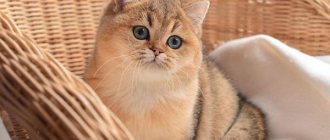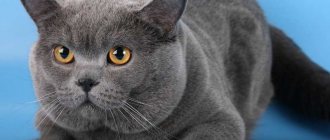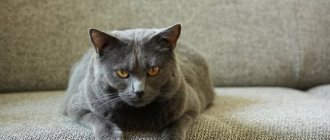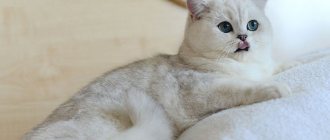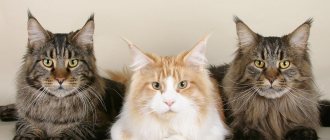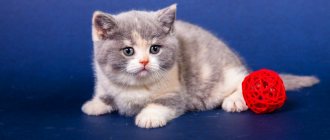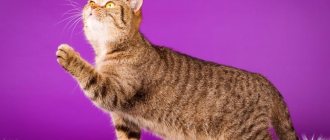Solid (solid, plain)
A solid color implies the absence of any slightest admixture of other shades. The surface of the fur is colored evenly on all parts of the body. The Scots once upon a time considered gray or blue to be the most common color. These are the favorites most often found among breeders. But today seals with other colors are also gaining more and more popularity: white, chocolate, black, brown, cream, red and fawn (which literally means the color of a young deer). Sometimes it happens that nature interferes with the uniform color of the fur and leaves a mark of a different color there. Such cats noticeably lose value because they are considered a breed defect.
Point (point)
The more common name for this color is color point. It is characterized by the fact that the main color of the animal turns into a darker color at the tip of the muzzle, tail, ears and paws. This is due to the fact that in the blood of such animals there is a special gene that affects the darkening of the hair in those parts of the body where the temperature is low.
There are several variations of this color, which are shown in the table below, there may be others:
| Color name, photo | Main color | Additional color |
| Seal Point | Light beige | Brown |
| Lilac Point | White | Lilac |
| Blue Point | Pale blue | Dark blue |
| Chalklit Point | White | Brown |
| Cream-point Cream-blue-point | Pale cream | Cream |
| Red point | Pale cream | Ginger |
| Tabby (lynx) point | Any | Stripes to match the main color |
| Torty point | Tortoiseshell | Red or cream spots on the base coat color |
Torti (turtle)
It should be noted right away that you can only buy a turtle girl. In males, this color is not provided by genetics. But if you do come across a cat like this, then this is a big exception, which, however, does not increase its cost, but, on the contrary, reduces it.
Tortoiseshell color is considered to be fur on which spots of different colors (black, chocolate, blue, lilac) alternate with red or cream marks. For breeders, a particularly important indicator is the intensity of pigment expression and uniformity of location.
Smoky (smoky, smoky)
The main condition for this color is that the hairs at the base of the body must have a silver-white tint. Those. the silvery-white hair turns into another color, such as black or blue. This phenomenon is called typing and occurs as a result of a dominant silver gene. The smoke can be different, for example, chocolate.
There are often cats with additional patterns on their fur, but according to color rules this should not be the case.
Don't confuse this color with a solid color! If you're not sure, part your cat's fur and see what color is at the base of his fur.
SILVER SHADED BRITISH: BRITISH CATS, CATS, KITTENS: PHOTO GALLERY
We are pleased to introduce the silver shaded British. In the photo there are British cats, cats, kittens of a real correct silver shaded color.
| In our cattery you can “buy a real British kitten.” We have many different colors, we will help you choose and answer all your questions! |
Tabby (tabby)
Such cats have stripes of an unusual shape and a different color than the main color. The most common marks are on the forehead, for example, in the shape of the letter M, light spots on the back of the ears, a necklace on the chest, rings on the paws and tail, curls on the cheeks, eyes outlined as if with shadows.
Breeders distinguish several variants of tabby. According to the type of pattern, they are marbled (shaded), tiger (mackerel) and spotted (spotted).
There is a complex classification of Scots tabby dogs based on combined colors and shades. They are presented in the table below:
| Name | Main color | Pattern color |
| Silver | Silver | Black |
| Silver blue | Light blue, white undercoat | Mantle on muzzle, tail and sides |
| Red | Light red | Bright red |
| Brown | Copper | Black |
| Blue | Cream blue | Bright blue |
| Cream | Pale cream | Beige or dark cream |
| Cameo | White | Bright red |
SILVER SHADED BRITISH CATS: VARIETIES OF COLOR
British chocolate silver shaded BRI bs 11: photo
Shaded silver British (chinchillas) can be of the following colors:
- black silver shaded BRI ns 11;
- blue silver shaded BRI as 11;
- lilac silver shaded BRI cs 11;
- chocolate silver shaded BRI bs 11;
- silver shaded cinnamon BRI os 11;
- faun silvery BRI shaded ps 11.
British cat lilac silver shaded BRI cs 11: photo
Shedded (shaded)
With this type of color, two-thirds of the hair starting from the base is white, and the remaining part can be red, silver or gold. On the chin, belly and lower surface of the tail the color is light. The shaded color does not allow spots or stripes except those located on the forehead or paws.
Representatives of the Scottish breed with a similar color have white coat color as the main color, and the tail and muzzle are decorated with a different color or a combination of both (torti). There may also be spots on the body and paws.
SHADED BRITISH SILVER KITTENS
Shaded British Silver kittens can be born from parents of this color or from carriers of this color. At birth, shaded is similar to white in color, and it is very difficult to determine the degree of tipping and accurately say about the color. In any case, this gene must be present in the pedigree, and the fewer patterned colors there are in the pedigree, the better. At birth, kittens usually have quite a lot of residual pattern, which with age “blurs out” and turns into a shaded color.
Shaded British silver kittens always look very expensive and elegant, and also, undoubtedly, evoke pride and admiration of others.
The rarest colors of Scottish cats
Several years ago, the highest price was set for kittens of unusual silver and gold shades. But in the modern cat market there are more and more of them. Today, ticked Scots and golden chinchillas are considered the most expensive.
Scottish straight golden chinchilla
Interesting! The most common iris color among Scots is gold. However, there are some exceptions. Usually the eye color matches the coat. Blue or multi-colored eyes are quite rare, these animals can be white, bicolor or tortie. Orange iris is a very beautiful, but the rarest eye color in this breed.
Genetics of Scottish cat colors
In cats of this breed, 2 genes predominate, which are responsible for the red and black color. One of them acts as dominant, and the other as recessive (i.e., the one that is suppressed). There is also a 3 diluent gene, which is responsible for the saturation of the pigment. These genes are combined and as a result we get a variety of colors: from the well-known blue to the cheerful-looking harlequin.
By the way, while the kitten is still small (several weeks), it is impossible to say exactly what its color will be. The final coloring is formed when, after a child's molt, the coat is replaced by an adult coat. Usually the color is ready by six months, although it may change slightly for another 1.5 years.
Scottish cat color charts
When purchasing a Scottish kitten with a passport from a breeder, most likely you will see markings of numbers and letters there. This is an international code used in the classification accepted among breeders. The Scottish breed includes four cats: fold-eared (Scottish Fold), straight-eared (Scottish Straight), long-haired fold-eared (Highland Fold), straight-eared long-haired (Highland Straight).
This is what the color code looks like: XXX.xx.NN.NN.NN.(NN) , where:
XXX . Abbreviated name of the breed in three capital letters: SFS - Scottish Fold, SFS 71* - Scottish Straight, SFL - Highland Fold, SFL 71* - Highland Straight.
xx . Lowercase letters indicating the main coat color (up to two):
| Letter (designation) | English name | Russian name |
| a | blue | blue |
| b | chocolate, brown, chestnut | chocolate, brown, Havana, champagne |
| c | lilac, lavender | lilac, lavender, platinum |
| d | red, flame | red |
| e | cream | cream |
| f | tortoiseshell, patch | tortoiseshell |
| g | blue-cream, blue-tortie | blue cream, blue tortoiseshell |
| h | chocolate-tortie | chocolate tortoiseshell |
| j | lilac-tortie | lilac tortoiseshell |
| n | black, ebony, seal, sable, ruddy | black, ebony, seal, sable, wild |
| o | sorrel, cinnamon, honey | sorrel, cinnamon, honey |
| p | beige fawn | yellow-brown, beige |
| q | sorrel tortie | red-brown tortoiseshell |
| r | beige fawn cake | beige tortoiseshell |
| s | silver, smoke | silver, smoky |
| w | white | white |
| y | golden | golden |
| z | unregistered | unregistered |
NN.NN.NN.(NN) - values of pairs of digits (up to 3 main and 1 auxiliary):
- Numbers from 1 to 35, which decipher the color features (harlequin, van, smoke, etc.):
| Letter (designation) | English name | Russian name |
| 01 | van | van |
| 02 | harlequin | harlequin |
| 03 | bicolour | two-color, bicolor |
| 04 | mitted/white point | with white markings (for color points) |
| 09 | little white spots | white spotting (1-2 cm) |
| 11 | shaded | shaded (1/4 of the top part of the hair is darkened) |
| 12 | tipped, shell | veiled (1/8 of the top part of the hair is darkened) |
| 21 | tabby, agouti | striping, agouti factor |
| 22 | blotched, marble | marble |
| 23 | mackerel, tiger | mackerel, tiger |
| 24 | spotted | spotted |
| 25 | ticked | ticked or Abyssinian |
| 31 | burmese | Burmese |
| 32 | tonkinese | Tonkinese |
| 33 | himalayan or siam | Himalayan, Siamese, point |
| 34 | Singapore | Singaporean |
| 35 | abyssinian | Abyssinian |
- A pair of numbers from 51 to 54 indicating the length of the tail:
| Letter (designation) | English name | Russian name |
| 51 | rumpy | taillessness |
| 52 | rumpy riser | remainder of the tail – 1-2 vertebrae |
| 53 | stumpy | bob – 7-13 cm. curled tail |
| 54 | longy | long/normal tail |
- A pair of numbers from 61 to 67 indicating eye color:
| Letter (designation) | English name | Russian name |
| 61 | blue | blue |
| 62 | yellow, golden | yellow, orange, golden |
| 63 | oddeyed | disagreement |
| 64 | green | green |
| 65 | burmese | Burmese cat eye color |
| 66 | onkinese | Tonkinese cat eye color |
| 67 | himalayan or siam | eye color of Himalayan and Siamese cats |
- A pair of numbers 71 (straight) or 73 (dropping), indicating the shape of the ears.
British cat color ns25
Since I deal with precious colors, the story will be about them. The colors of cats in pedigrees have symbols (abbreviations) - a digital and alphabetic code. The British Shorthair breed is designated by the letters BRI (British Shorthair), and the British Longhair breed by BRL (British Longhair). Other breeds also have their own designations, for example, Maine Coons - MCO, Siberian - SIB, etc. The color itself combines a combination of letters and numbers. For example, my cat Dusya (Fay Miranda) has a color of ns 12, where n is black s is silver 12 is a color variation. In this case, a chinchilla (veiled), in which only 1/8 of the hair is colored black. There can only be one letter in a color, for example a (denotes a solid blue color). Or it may contain additional numbers, for example: ns 12 33, where 33 is the designation of color point, i.e. blue eyes (exaggerated). Returning to silver, things are not so simple. There are color variations, for example: ns 11 - black silver shaded (1/3 of the hair is colored with color, i.e. the body of the cat is darker than a chinchilla, but lighter than a ticked one (the latter often show a residual pattern) In the photo - mine Empire graduate: the ticking is more visible on her, there is more residual pattern on the tail.
ns 12 - black silver chinchilla (1/8 of the hair is colored, the lightest variation of the silver color). In the photo - Duska: the tail does not have a residual pattern in the form of open rings, there is visible ticking on the body only along the spine.
but the next color goes somewhat separately, as it relates to tabby colors: ns 25 - black silver ticked (Ticked hairs are evenly distributed throughout the coat, giving a speckled or freckled color, often there is a residual pattern. Comparatively darker than chinchilla colors). Here is also my graduate Sheriya - her ticking is very pronounced, she has a characteristic “cuff” and half rings on her tail.
In this case, the undercoat, chin, ear hair, belly, chest, inside of the legs, and underside of the tail must be white. Closed rings on the paws/tail or the so-called “necklace” (a closed ring on the animal’s neck) are not allowed. The situation with gold is the same, only in the encoding instead of “s” it is written “y” - which means gold. Another difference between golden ones: their undercoat should be a soft peach color.
ny 11 (black golden shaded) - photo taken from the Meow forum, but this is a cat that I sincerely admire for its perfect golden color! Winston Silver Laisa ow. Sarah Kireeva
ny 12 (black golden chinchilla) - a cat from the GoldenBri nursery, a very bright representative of this color
ny 25 (black golden ticked) - male from the friendly cattery "Elite-Elegant" in Sochi
In precious colors, variation 12 is highly valued, as it is the rarest. It is very difficult to get a quality 12 color with excellent outline. Another interesting thing is that in these colors the first letter n is not always, i.e. black. It can be very diverse: blue (a), chocolate (b), cream (e), red (d) - it will already be called cameo, etc. Now there is a huge variety of colors! The blue gold color is of great interest. It looks very unusual. The group of points is also specific (blue points, golden points, etc.). If you are interested, you can look it up online - these colors are worth your attention! In conclusion, I would like to say that at the moment these colors are still rare in a different type, because they were obtained “from outside,” that is, by the influx of blood from Persian and Abyssinian cats.
How coat color affects the character of a Scotsman
When purchasing a pet, you should not chase fashion; it is better to trust your preferences and tastes. The main thing is that the cat turns out to be “yours” in temperament and character. By the way, some cat owners are sure that the color of the fur affects the behavior of the animal and leaves an imprint on its character.
White and light colored
You want to cuddle these babies endlessly. But they, as a rule, do not like increased attention to themselves. Although they are very loyal to the owner, they are extremely wary and wary of other people. Among some peoples there is a belief that a white cat brings good luck. Whether this is true or not is not known for certain. But the white color can cause a lot of problems for the cats themselves, since 5% of all snow-white cats are born completely deaf. Previously, it was believed that deafness was the fate of absolutely all white-furred tails, but later scientists proved that this is not so. But when buying such a kitten, you should still be more careful.
Black
Despite all the existing prejudices and myths regarding black cats, in practice they are one of the friendliest towards people. They like to stay close to their owner all their free time and always keep him in sight. Charcoal cats are wise, quick-witted, and keenly aware of a person’s mood.
Redheads
Such animals are a ray of sunshine in your home. It is believed that a ginger cat in the home is the key to an indispensable increase in well-being. Those with fiery fur are very playful, willful, cheerful and curious creatures. The golden shades of fur that are fashionable today are characteristic of more formidable animals, whose disposition can hardly be called friendly. And golden Siamese cats are generally considered the worst tailed cats.
Blue and silver
Silver and blue fluffies are real aristocrats. Calm, balanced, noble. They love their owner devotedly, although they are not always ready to demonstrate this publicly. It is believed that these four-legged pets are able to calm and relieve stress in humans. In addition, cats of this color are absolutely not vindictive.
Two-color
Such cats are most in demand among buyers. In addition to their interesting color, they have an easy-going disposition, are friendly, and kind even towards children. Bicolor cats love their owners very much and get along well with other pets.
TYPED GOLDEN COLORS OF CATS. A guide to identifying colors in pictures.
GOLDEN CHINCHILLA(veiled)
The coat is a golden veiled color. The ideal undercoat color is a rich warm cream, but it can vary from radiant copper or copper brown to light apricot. The base color specks occupy about 1/8 of the length of the hairs. Back, sides, head, ears, tail , as well as the muzzle and legs with light speckling. The chin, ear tufts, chest and belly, the inside of the legs and the lower part of the tail should be in the same tone as the undercoat. The coat should not have any pattern.
A striped pattern, closed rings on the legs, an undercoat mixed with brown tones, a white or almost white chin, connected in one way or another with a light chest, ears and belly, are considered a vice and exclude the possibility of receiving a reward.
Golden chinchilla.
The nose is brick-red with a brown rim. The paw pads are brown-black. The eye color is even green or green-blue with a brown-black rim of the eyelids. Green is preferable.
Golden blue chinchilla
. The eyes are green or green-blue with a blue rim of the eyelids. The nose is deep pink, with a blue border. Paw pads are blue.
Also Golden Lilac Chinchilla.
GOLDEN SHADED.
The coat is a golden shaded color. The ideal undercoat color is a rich warm cream, but it can vary from radiant copper brown to light apricot. The base color specks occupy approximately 1/4 or 1/3 of the length of the hairs. The speck runs from the back to the sides, slightly extending beyond the legs. A slight striped pattern is allowed on the legs. The muzzle and upper part of the tail are also speckled. The chin, ear tufts, chest and belly, the inside of the legs and the lower part of the tail should be in the same tone as the undercoat.
In general, the golden shaded cat is darker than the golden veiled (chinchilla).
A striped pattern, closed rings on the legs, mixed with brown tones, an undercoat, a white or almost white chin, connected in one way or another with a light chest, ears and belly, are considered a fault and exclude the possibility of receiving a reward.
Golden shaded.
The eyes are even green or green-blue in color with a brown-black rim of the eyelids. The nose is with a brown-black rim. The paw pads are brown-black.
Golden blue shaded
. The eyes are an even green or green-blue color with a blue rim of the eyelids. The nose is deep pink with a blue rim. The paw pads are blue.
Also golden lilac shaded
.
GOLDEN SMOKE COLOR.
In smoky hair color, about half of the hair is colored. The root of the hair is cream or light apricot in color, the tip is colored. Thanks to this distribution of pigment throughout the hair, the coat appears fully colored with a lighter “collar”.
From above, in a calm state, the cat looks like it is evenly colored, and only when in motion does the golden part of the color become noticeable. The width of the golden part varies from a thin stripe on the head and legs, which is noticeable only with careful analysis of the fur, to almost golden wool on the collar and tassels ears, belly and lower part of the tail. A light gold lightened M-shaped pattern on the head is allowed.
Young animals often have stripes or reverse contrasts in color, which usually disappear with age. In adult animals, any pattern, spots, other tones in color or reverse contrasts are considered a defect and exclude the possibility of receiving a reward.
Since shading is combined with both black-base and red-base colors, it can appear in all tortoiseshell colors.
Theoretically, golden undercoat can also be obtained in a red-base color, but so far breeders have not found such a combination worthy of attention. Lack of contrast in Red Gold Shaded
makes the effect almost indistinguishable, but in the black spots
of Tortoiseshell Golden Shaded
or
Tortoiseshell Golden Chinchilla
it can be quite noticeable.
Updated 15 Feb 2017
.
Created 22 Feb 2016
Stop color ns12 (chinchilla)
For various reasons, the phenotypic division into Shell, Shaded and Smoke is very arbitrary. In practice, all these colors phenotypically smoothly flow from one to another. There are many variations and quality grades of these colors: shaded chinchillas, light and dark shaded silvers, smokes with insufficient tipping or virtually no root highlighting of the hair. The length of the tipping (dyed part of the hair) and the intensity of the contrast with the undyed part of the hair is largely determined by polygenes. In addition to polygenes, the entire silver group of colors depends on age and seasonal changes: the pigment is produced only at the beginning of hair growth, so during periods of molting and new hair growth we are not able to see the true color of the animal. The Shell and Shaded colors (shaded chinchillas and silver shaded) are combined into one color group with the same name “tipped”.
Jean Paul Maas advises using the following criteria in judicial practice:
1. If the question arises whether the cat is too dark a chinchilla or too light a silver shaded, then use the outside of the hind legs to the hock as a guide. If the coat color in this place is white, then the cat is assessed as a chinchilla; if it’s gray, then it’s like shaded silver.
2. If the question arises whether the cat is too dark silver shaded or too light smoke, then you need to use the mirror of the nose as a guide. If a cat has an “agouti nose”, then it is rated as silver shaded; if the mirror of the nose is completely colored, then it looks like smoke.
3. If the question arises whether the cat is smoky with insufficient contrast or is it a solid color (at least not silver) with uneven color along the length of the hair, then they are guided by the ear brushes (not at the tips of the ears, but in the ears). If the ear brushes are white, then we judge the cat as smoky, if not, then it is in no way related to the silver color.
Articles Cat colors, Pigmentation, Shaded colors, Genetics, BRI SFS breed standards, Color parameters, Spot stripe pattern, Ticking and tabby, Mendel's laws, Felinology, Pigmentogenesis, British cats, Highlanders (longhair), Scottish Fold
In this article YOU will learn why the main characteristics of the color of a cat’s coat, skin and eyes depend.
Continued >>> Color parameters
If your kitten (feline) has stripes, then its pattern is “tabby” (sometimes called “brindle”). All tabbies have fine lines on their muzzle that define their eyes and form an "M" on their forehead. The article describes the main parameters of similar colors. Continued >>>
The previous paragraphs described solid colors. However, these colors are not the most common. Many cats are ticked, and most are ticked in a different color than the main one, a pattern called tabby. In this article we will try to understand the intricacies of ticking and tabby. Continued >>>
This section describes the standards for assessing breeds of the most common felinological systems in Russia.
Continued >>> History and current state of the breed by Yulia Fedorova 2008 The article contains the main milestones in the formation and development of the breed, its development and current state.
Article-excerpt from the ZooBest IC brochure “British cats” 2008. Continued >>> Here are the basics of raising a kitten. How to raise a healthy kitten, how to care for it, what to feed it, how to help settle into a new home and get to know other pets. You can read all this and much more in the article: “A kitten in your home.”
Birth and developmental stages of kittens
author Kazarez N. 2005 This article is devoted to familiarization with the developmental features of a kitten from birth to the moment of transfer to permanent owners. The material will be very useful for beginning breeders who are about to raise their first litter. Continued >>>
Kitten price
author Fedorova Yu. 2007 This article will allow you to understand what the cost of a kitten consists of and how the breeder determines it.
Argus

